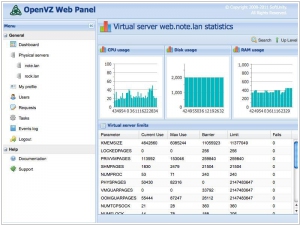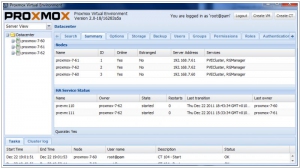OpenVZ vs Proxmox
June 12, 2023 | Author: Michael Stromann
6

OpenVZ is container-based virtualization for Linux. OpenVZ creates multiple secure, isolated Linux containers (otherwise known as VEs or VPSs) on a single physical server enabling better server utilization and ensuring that applications do not conflict. Each container performs and executes exactly like a stand-alone server; a container can be rebooted independently and have root access, users, IP addresses, memory, processes, files, applications, system libraries and configuration files.
OpenVZ and Proxmox are both virtualization solutions, but they differ in their approach and feature sets.
OpenVZ is an operating system-level virtualization platform that allows for the creation of multiple isolated containers, also known as virtual private servers (VPS), on a single physical server. It relies on a shared kernel, where the host and all containers run on the same operating system. OpenVZ is known for its lightweight nature and efficient resource utilization, making it suitable for high-density server environments. However, it is limited to Linux-based operating systems and lacks support for running different operating systems within containers.
Proxmox, on the other hand, is a complete virtualization management platform that incorporates multiple virtualization technologies, including KVM (Kernel-based Virtual Machine) and container-based virtualization (LXC). It provides a hypervisor (Proxmox VE) and a web-based management interface that allows for the management of both virtual machines and containers. Proxmox supports a wide range of operating systems, including Linux, Windows, and BSD, offering greater flexibility and compatibility. It also provides advanced features such as live migration, high availability, and backup/restore capabilities.
See also: Top 10 Virtualization platforms
OpenVZ is an operating system-level virtualization platform that allows for the creation of multiple isolated containers, also known as virtual private servers (VPS), on a single physical server. It relies on a shared kernel, where the host and all containers run on the same operating system. OpenVZ is known for its lightweight nature and efficient resource utilization, making it suitable for high-density server environments. However, it is limited to Linux-based operating systems and lacks support for running different operating systems within containers.
Proxmox, on the other hand, is a complete virtualization management platform that incorporates multiple virtualization technologies, including KVM (Kernel-based Virtual Machine) and container-based virtualization (LXC). It provides a hypervisor (Proxmox VE) and a web-based management interface that allows for the management of both virtual machines and containers. Proxmox supports a wide range of operating systems, including Linux, Windows, and BSD, offering greater flexibility and compatibility. It also provides advanced features such as live migration, high availability, and backup/restore capabilities.
See also: Top 10 Virtualization platforms



